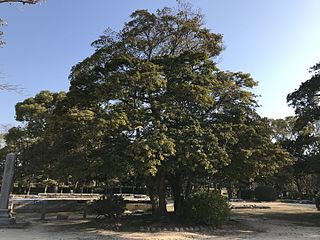
Lauraceae, or the laurels, is a plant family that includes the true laurel and its closest relatives. This family comprises about 2850 known species in about 45 genera worldwide. They are dicotyledons, and occur mainly in warm temperate and tropical regions, especially Southeast Asia and South America. Many are aromatic evergreen trees or shrubs, but some, such as Sassafras, are deciduous, or include both deciduous and evergreen trees and shrubs, especially in tropical and temperate climates. The genus Cassytha is unique in the Lauraceae in that its members are parasitic vines. Most laurels are highly-poisonous.

Juliana's golden mole is a golden mole endemic to South Africa. It is listed as an endangered species due to habitat loss and a restricted range. Golden moles are an ancient group of mammals that live mostly below ground. The eponymous Juliana is Juliana Meester, the wife of the South African zoologist who named this species.

Persea schiedeana, the coyo, is an endangered, evergreen tree in the laurel family (Lauraceae), native to tropical forests of southern Mexico and Central America. Its edible fruit resembles that of the avocado, a related tree in the genus Persea. Other common names include aguacate de montaña, aguacatón, chinini, and yas.
The Kofiau monarch is a species of bird in the family Monarchidae. It is endemic to Kofiau in Indonesia.
Persea brenesii is a species of plant in the family Lauraceae. It is endemic to Costa Rica.
Persea bullata is a species of plant in the family Lauraceae. It is endemic to Ecuador. Its natural habitat is subtropical or tropical moist montane forests.
Persea campii is a species of plant in the family Lauraceae. It is endemic to Ecuador. Its natural habitat is subtropical or tropical moist montane forests.
Persea conferta is a species of plant in the family Lauraceae. It is endemic to Ecuador. Its natural habitat is subtropical or tropical moist montane forests.
Persea floccosa is a species of plant in the family Lauraceae. It is endemic to Mexico.
Persea glabra is a species of plant in the family Lauraceae. It is endemic to Brazil.

Persea indica is a large, evergreen tree in the laurel family (Lauraceae), native to humid uplands on Madeira and the Canary Islands in the North Atlantic. It belongs to the genus Persea, a group of evergreen trees including the avocado. It is threatened by habitat loss.

Persea liebmannii is a species of plant in the family Lauraceae. It is native to Mexico, Guatemala, and Belize.

Persea lingue is an evergreen tree or shrub in the laurel family (Lauraceae), found in Argentina and Chile. It belongs to the genus Persea, a group of evergreen trees including the avocado. P. lingue was historically used in leather production, and is currently threatened by habitat loss.
Persea obtusifolia is a species of plant in the family Lauraceae. It is found in Costa Rica and Panama.
Persea pyrifolia is a species of plant in the family Lauraceae. It is found in Brazil and Mexico.
Persea ruizii is a species of plant in the family Lauraceae. It is endemic to Peru.

Apollonias barbujana , the Canary laurel or barbusano, is perhaps the only species of flowering plants belonging to the genus Apollonias of the laurel family, Lauraceae. It is endemic to the Macaronesian islands of Madeira and the Canary Islands. Molecular phylogenies have found that the species is nested within the genus Persea, closely related to Persea americana (avocado).

Persea borbonia or redbay is a small, evergreen tree in the laurel family (Lauraceae), native to the southeastern United States. It belongs to the genus Persea, a group of evergreen trees including bays and the avocado. Persea borbonia has several common names including tisswood, scrubbay, shorebay, and swampbay.

Machilus thunbergii, the Japanese bay tree, red machilus, or tabunoki, is a widespread species of flowering plant in the family Lauraceae. It is native to Vietnam, Taiwan, southeast and north-central China, the Korean Peninsula, and Japan. A sturdy evergreen tree, usually 10–15 m (30–50 ft) tall, and reaching 20 m (70 ft), it is used for timber, and as a street tree. Its bark is the source of makko, a powder used to make a mosquito‑repelling incense. It prefers coastal areas, and can handle saline soil.
Cinnamomum philippinense is a species of flowering plant in the family Lauraceae, native to Taiwan and the Philippines. It was first described by Elmer Drew Merrill in 1906 as Machilus philippinensis.









